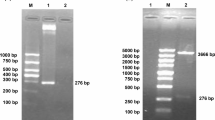Abstract
The protective antigen (PA) of Bacillus anthracis is a potent immunogen and an important candidate vaccine. In addition, it is used in monitoring systems like enzyme-linked immunosorbent assay to assess antibodies against PA in immunized subjects. The low level of PA production in B. anthracis and the difficulty of separating it from other bacterial components have made the researchers do different studies with the aim of producing recombinant PA (rPA). In this study, to produce rPA as a recombinant protein vaccine, the partial sequence of protective antigen of B. anthracis, amino acids 175–764, as a potent immunogenic target was inserted in pET21b(+). This is a prokaryotic plasmid that carries an N-terminal T7.tag sequence. The integrity of constructed plasmid was confirmed using restriction enzyme mapping. rPA was expressed after induction with isopropyl β-d-1-thiogalactopyranoside in Escherichia coli BL21. Purification of rPA was done with an affinity system using anti T7.tag antibody. Electrophoresis and Western blotting confirmed the specificity of the expressed protein. BALB/c mice were immunized with obtained PA protein and evaluation of specific immunoglobulin G antibodies against PA in sera using Western blotting method and showed that rPA is immunogenic. The challenge of immunized mice with virulent strain of B. anthracis showed that rPA is functional to protect against pathogenic strain.



Similar content being viewed by others
References
Weiss, M. M., Weiss, P. D., & Weiss, J. B. (2007). American Journal of Public Health, 97, 1945–1951. doi:10.2105/AJPH.2006.102749.
Petosa, C., et al. (1997). Nature, 385, 833–838. doi:10.1038/385833a0.
Vahedi, F., et al. (2005). Iranian Journal of Immunology, 3, 134–140.
Brossier, F., Guidi-Rontani, C., & Mock, M. (1998). Comptes Rendus des Seances de la Société de Biologie et de ses Filiales, 192, 437–444.
Mourez, M., et al. (2003). Proceedings of the National Academy of Sciences of the United States of America, 100, 13803–13808. doi:10.1073/pnas.2436299100.
Baillie, L. W. (2006). Journal of Applied Microbiology, 101, 594–606. doi:10.1111/j.1365-2672.2006.03112.x.
Splino, M., et al. (2005). Annals of Saudi Medicine, 25, 143–149.
Grunow, R., et al. (2007). Vaccine, 25, 3679–3683. doi:10.1016/j.vaccine.2007.01.056.
Rhie, G. E., et al. (2005). FEMS Immunology and Medical Microbiology, 45, 331–339. doi:10.1016/j.femsim.2005.05.008.
Baillie, L. W., Johnson, M., & Manchee, R. J. (1994). Letters in Applied Microbiology, 19, 225–227. doi:10.1111/j.1472-765X.1994.tb00949.x.
Chauhan, V., et al. (2001). Biochemical and Biophysical Research Communications, 283, 308–315. doi:10.1006/bbrc.2001.4777.
Gupta, P., Sahai, V., & Bhatnagar, R. (2001). Biochemical and Biophysical Research Communications, 285, 1025–1033. doi:10.1006/bbrc.2001.5282.
Gwinn, W., et al. (2006). Protein Expression and Purification, 45, 30–36. doi:10.1016/j.pep.2005.04.009.
Hepler, R. W., et al. (2006). Vaccine, 24, 1501–1514. doi:10.1016/j.vaccine.2005.10.018.
Laemmli, U. K. (1970). Nature, 227, 680–685. doi:10.1038/227680a0.
Bradford, M. (1976). Analytical Biochemistry, 72, 248–254. doi:10.1016/0003-2697(76)90527-3.
Miroux, B., & Walker, J. E. (1996). Journal of Molecular Biology, 260, 289–298. doi:10.1006/jmbi.1996.0399.
Novak, J. M., et al. (1992). The Journal of Biological Chemistry, 267, 17186–17193.
Friedman, T. C., et al. (1995). Archives of Biochemistry and Biophysics, 316, 5–13. doi:10.1006/abbi.1995.1002.
Vodkin, M. H., & Leppla, S. H. (1983). Cell, 34, 693–697. doi:10.1016/0092-8674(83)90402-6.
Sharma, M., et al. (1996). Protein Expression and Purification, 7, 33–38. doi:10.1006/prep.1996.0005.
Ahuja, N., Kumar, P., & Bhatnagar, R. (2001). Biochemical and Biophysical Research Communications, 286, 6–11. doi:10.1006/bbrc.2001.5337.
Gupta, P., Waheed, S. M., & Bhatnagar, R. (1999). Protein Expression and Purification, 16, 369–376. doi:10.1006/prep.1999.1066.
Quinn, C. P., et al. (1988). The Biochemical Journal, 252, 753–758.
Hambleton, P., & Turnbull, P. C. (1990). Advances in Biotechnological Processes, 13, 105–122.
Author information
Authors and Affiliations
Corresponding author
Rights and permissions
About this article
Cite this article
Vahedi, F., Sankian, M. & Mahmoudi, M. Functional Expression of Bacillus anthracis Protective Antigen in E. coli . Appl Biochem Biotechnol 157, 554–561 (2009). https://doi.org/10.1007/s12010-008-8309-x
Received:
Accepted:
Published:
Issue Date:
DOI: https://doi.org/10.1007/s12010-008-8309-x




